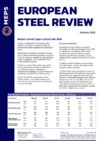Russian nickel ban an ‘upward driver’ of LME prices
The US and UK governments have implemented sanctions that will ban imports of nickel produced in Russia – more than two years after the start of the Russia-Ukraine war.
The sanctions will be implemented across LME and CME trading platforms, however Russian material that has been delivered into their warehouses prior to April 13, 2024, can still be traded.
Many market participants question why there has been such a long delay in taking this decision, when the Russia-Ukraine conflict has been raging for so long already. Some suggest that continued inaction by the metal exchanges to prohibit the influx of this material could be partly behind the legislative announcement.
MEPS head of price analysis and forecasts, Kaye Ayub, said: “The fear of a ban on Russian nickel was to blame for the LME price spike and, ultimately, the temporary suspension of trading on the LME nickel contract back in March 2022.
“The announcement of the ban now coming into force, though unlikely to illicit the same reaction, will still be an upward driver for nickel prices in the near term.”
The loss of this supply would pose a big issue for the liquidity in LME trading.
Russia is the second largest producer of class 1 nickel in the world and currently accounts for more than a third of all LME inventories.
Nevertheless, the approval of new supply into the LME from both Chinese and Indonesian producers could limit the effect of the decision to ban Russian nickel.
If the ban had been implemented prior to the authorisation of these new suppliers, then shortages may have been more significant than those that are now likely to occur in the coming months.
Daily LME nickel prices had already been on an upward trend in the first half of April due to concern about supply, resulting partly from slower than anticipated quota approvals in Indonesia. The cut in Russian deliveries into the LME is expected to exacerbate those fears.
Restrictions put in place following the suspension of nickel trading back in 2022 will prevent any increases above 15% in any trading day.
Downstream demand remains lacklustre and Russian nickel will likely be rerouted into other markets – potentially at a lower price. Consequently, the uplift in the LME price could be short-lived, especially if there is no discernible drop in inventories held in LME warehouses, as a result of the ban, over the coming months.
Ayub said: “With the 2024 demand outlook remaining weak for the stainless steel and electric vehicle (EV) sectors, the effect of the ban on Russian nickel may be mitigated in the medium term. However, in the longer term, we could see some inflationary pressures on the global nickel market.”

Source:
European Steel Review
The MEPS European Steel Review is an informative, concise and easy-to-use monthly publication, offering unique professional insight into European carbon steel prices.
Go to productRequest a free publication





